Bass, Largemouth
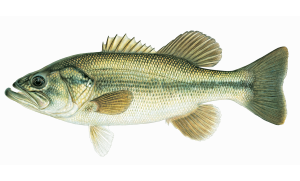
Scientific Name: Micropterus salmoides
Description: The jawbone extends beyond the back of the eye; the two dorsal fins are nearly separated or deeply notched. Up to 20 lb; 1 to 6 lb typical.
Habitat: Moderately clear to turbid, quiet warm waters in streams, rivers, lakes, reservoirs and ponds, around vegetation and near logs, trees, brush and stumps. Spawning activity begins when water reaches 63-68 degrees.
Tips: Will strike artificial baits including crankbaits, spinner baits, jigs, plastic worms or crayfish, earthworms, minnows, leeches and frogs. Best fishing early morning or late evening in warm summer months.
Range: Common throughout Georgia.
Current State Record Information
Bass, Altamaha
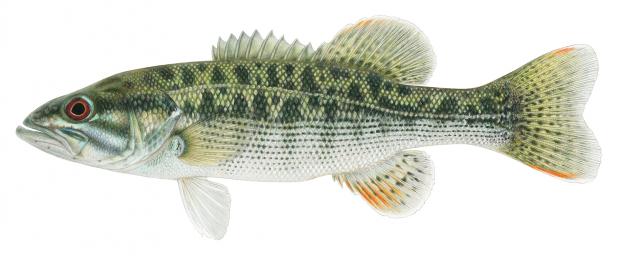
Scientific Name: Micropterus sp. cf. cataractae
Description: Altamaha bass differ from all other bass species in that the caudal fin is dark spotted with narrow orange upper and lower margins; the second dorsal and anal fins also have some orange coloration on their outer portions. Adult Size: 5–16 inches.
Habitat: Rocky areas with cool flowing water. They can also be caught around wood and undercut banks near rocky habitats with flowing water.
Tips: Cast lures into any little eddy or pool, especially in rocky shoal areas and retrieve. Try targeting them in the Yellow, Alcovy, Towaliga, any forks of the Oconee River and in the mainstem Oconee River down to Milledgeville.
Range: Found above the fall line in the Ocmulgee, Oconee and Ogeechee River basins.
Current State Record: None currently on file
Bass, Bartram's
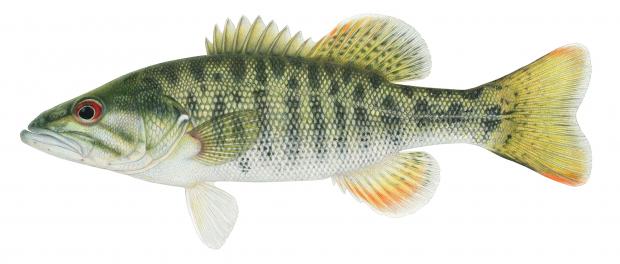
Scientific Name: Micropterus sp. cf. cataractae
Description: Bartram’s bass differ from all other bass species in that the caudal fin lacks notable spotting and has a narrow pale lower margin; the second dorsal, caudal and anal fins usually have some orange to yellow coloration on their outer portions. Adult Size: 5–16 inches.
Habitat: Rocky habitat with flowing water.
Tips: Natural color Zoom finesse worms such as green pumpkin or watermelon or any other small worms on a 1/8-ounce shakeyhead rigged weedless. Small Rooster tails or Satilla spins and floating Rapalas work well on light gear. Fly rod anglers should use streamers and poppers.
Range: Found above the fall line in the Savannah River basin.
Current State Record: None currently on file
Bass, Chattahoochee
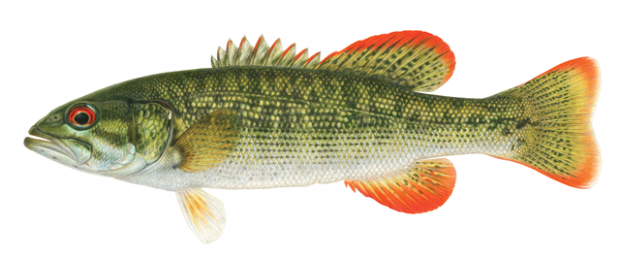
Scientific Name: Micropterus chattahoochee
Description: Chattahoochee bass differ from all other bass species in that the second dorsal, caudal, and anal fins have bright red/orange coloration on their outer portions and numerous dark spots. Typically 5-11 inches.
Habitat: Chattahoochee bass like rocky habitat with flowing water, concentrate on these areas. They can also be caught around wood and undercut banks.
Tips: They’ll strike at a variety of lures so give small jigs, grubs, crankbaits, minnow plugs and 4” plastic worms a try. They will aggressively strike topwater lures, especially in the summer.
Range: Chattahoochee River basin.
Current State Record: None currently on file
Bass, Redeye

Scientific Name: Micropterus coosae
Description: Redder fins than other black bass; dark pigment spots on belly, upper jawbone that does not extend beyond the eyes. First and second dorsal fins connected. Up to 3 ½ lb; 2 lb and less typical.
Habitat: Rocky areas and large woody debris in cool water rivers and small streams. Spawning activities occur in waters 60-70 degrees.
Tips: Scrappy fighter. Use eggs, crayfish, in-line spinners, shallow-running minnow or crayfish type plugs.
Range: Tennessee and Coosa River basins.
Current State Record Information
Bass, Shoal
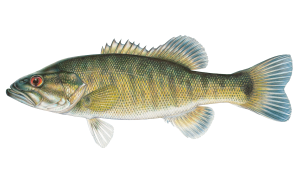
Scientific Name: Micropterus cataractae
Description: Unlike largemouth bass, the upper jaw does not extend beyond the eyes and the dorsal fin is continuous and not deeply notched. They are most like the redeye basses, but do not have any red coloration in the fins or pale margins on the tail. Unlike smallmouth bass they usually have a large dark spot at the base of the tail. Adult Size: 12–24 inches.
Habitat: Found around current breaks near flowing water. This can be in the middle of a big shoal, in a deep-water bend of the river with large boulders or on the bank behind a tree in the water. The key is almost always that there is some flow.
Tips: Anything that will catch a largemouth bass will also work on shoal bass.
Range: Native to the Chattahoochee and Flint River basins; introduced in the Ocmulgee and Oconee Rivers.
Current State Record Information
Bass, Smallmouth

Scientific Name: Micropterus dolomieui
Description: Brown or bronze color on the sides. Jawbone does not extend behind rear margin of eye. Connected first and second dorsal fin. Up to 10 lb; 1 to 3 lb typical.
Habitat: Prefers clear water lakes and cool swift streams with rocky bottoms. Tends to avoid bright light and is most active at dawn. Spawns in water 60 - 65 degrees in pools with gravel bottoms.
Tips: Use natural or artificial crayfish, jigs, minnows or hellgrammites.
Range: Tennessee and lower Savannah River basins.
Current State Record Information
Bass, Spotted
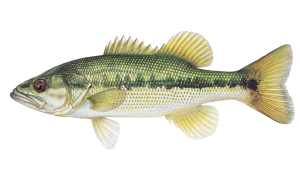
Common Names: Spotted bass; Alabama bass; Kentucky bass
Scientific Name: Micropterus punctulatus, Micropterus henshalli
Description: Evenly arranged black spots in alternate rows below the dark lateral line. Small rough patch of teeth on tongue. Connected first and second dorsal fin. Up to 8 lb; 1-4 lb typical. Spotted bass can hybridize easily with other black bass and threatens native black bass species. Never move fish to new bodies of water.
Habitat: Prefers rocky areas in clear streams and lakes. Spawning takes place in spring when water temperatures reach 62-68 degrees.
Tips: Use natural or artificial crayfish, worms, shad-like crankbaits, spinner baits, or worms fished near the bottom.
Range: M. punctulatus are native to Tennessee River basins. M. henshalli are native to Coosa and Tallapoosa River basins but are now found in most rivers and reservoirs in Georgia above the fall line due to anglers moving this species around.
Current State Record Information
Alabama Bass

Bass, Suwannee

Scientific Name: Micropterus notius
Description: Suwannee bass have a series of dark, vertical, diamond shaped blotches along the lateral line, which may form a band. Mature Suwannee bass may have bright bluish coloring on the cheeks, breast and ventral parts. Unlike largemouth bass, the upper jaw does not extend beyond the eyes and the dorsal fin is continuous and not deeply notched. Adult size: Up to 16 inches.
Habitat: Deep sweeping bends, larger adults prefer to hang out in woody cover similar to largemouth. Target structure in the river such as cypress trees, boulders or laydowns.
Tips: Crawdad jigs or crayfish imitating soft plastics and brush hog imitations rigged Texas style with a ¼ ounce bullet weight.
Range: Found only in the Alapaha, Ochlockonee and Withlacoochee Rivers.
Current State Record Information
Bass, Tallapoosa

Scientific Name: Micropterus tallapoosae
Description: Tallapoosa Bass differ from all other bass species in that the second dorsal, caudal and anal fins have yellow-green coloration with white edges. Adult Size: 5–16 inches.
Habitat: Rocky habitat with flowing water, so concentrate on these areas. They can also be caught around wood and undercut banks.
Tips: Small jigs, grubs, crankbaits, minnow plugs and 4” plastic worms. They will aggressively strike topwater lures in the summer.
Range: Found in the Tallapoosa River basin.
Current State Record Information: None currently on file
Bass, White
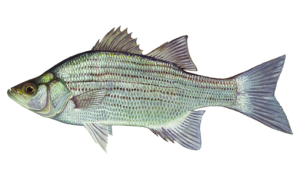
Scientific Name: Morone chrysops
Description: Silvery fish with several faint horizontal stripes on the sides. Two dorsal fins are only slightly separated. Second anal spine 2/3 or more the length of third anal spine. One tooth patch on tongue. Up to 5 lb; ½ to 2 lb typical.
Habitat: Large streams, rivers and lakes. Travel in schools. During spawning, when water reaches 53-64 degrees, they move upstream into tributaries, especially headwaters, and onto wind-swept sand and gravel areas in lakes.
Tips: Trolling small plugs or spinners. Jigs and minnows are effective in lake arms and tributaries.
Range: Tennessee, Coosa, Chattahoochee, Flint, Ocmulgee, Oconee and Savannah River basins.
Current State Record Information
Bass, Striped
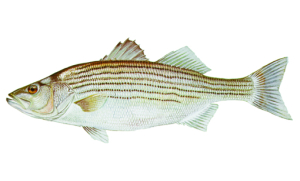
Scientific Name: Morone saxatilis
Description: Seven or eight heavy and distinct black stripes run length of slender body. Second anal spine ½ or less the length of third anal spine. Two tooth patches on tongue. Up to 80 lb; 5 to 25 lb typical.
Habitat: Can live in freshwater and saltwater environments. Coastal populations migrate from sea into inland estuaries and rivers for spawning. In large freshwater reservoirs and rivers, they tend to school in open waters, and will seek deep, cool areas of the reservoir or move upstream to cool water refuges during summer. Spawns during spring in flowing 55–67-degree water. The semi-buoyant eggs require many miles of flowing river water for egg development and maturation.
Tips: Large (green or white) jigs or minnows, and shad can be used to target striped bass. In fall, look for schools feeding near the surface, watch for seagulls diving on bait fish. Fish live shrimp or mullet in coastal river estuaries.
Range: Tennessee, Coosa, Chattahoochee, Flint, Ocmulgee, Oconee, Ogeechee, Ochlockonee, St. Marys and Savannah River basins.
Current State Record Information
Bass, Hybrid Striped x White (Hybrid Bass)

Scientific Name: Morone saxatilis X chrysops
Description: Seven or eight black stripes, broken and above the lateral line. Dark back, almost black with silvery sides and white belly. Body depth similar to white bass. Tongue with two tooth patches. Second anal spine 2/3 or more the length of third anal spine. To 20 lb; 1 to 10 lb typical.
Habitat: Produced in hatcheries and stocked in lakes and reservoirs. Prefers open waters.
Tips: Jigs and crank baits, live shad and cut bait. Trolling, cast to schooling fish.
Range: Tennessee, Coosa, Chattahoochee, Flint, Ocmulgee, Oconee, Altamaha and Savannah River basins.
Current State Record Information
Bass, Yellow
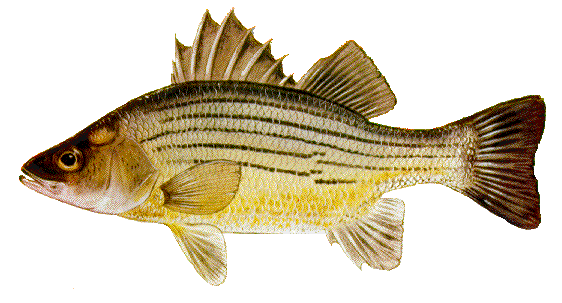
Scientific Name: Morone mississippiensis
Description: Distinct yellow color with dark, broken, horizontal stripes on sides; two dorsal fins are slightly connected. Second and third anal spines heavy and equal in length. No tooth patch on tongue. Rarely exceeds 1 lb.
Habitat: Large streams, rivers and lakes. Spawns when water reaches 55-60 degrees, over gravel bars or rocky shoals in tributary streams.
Tips: Most live bait or small artificial lures.
Range: Coosa River basin.
Bowfin

Scientific Name: Amia calva
Description: Body is yellow to yellow olive in color with a darker olive pattern on the back and sides. The belly is cream or white in color. Bowfin have a flattened head and a long, stout body with a mouth full of sharp teeth. There is a long dorsal fin across the top and a short anal fin, which easily distinguishes it from non-native invasive snakeheads that have a long anal fin. Males have a large black spot near the tail, bordered with orange. Breeding males also have brilliant turquoise-green ventral fins. Up to 20 lb, 1 to 10 lb is typical.
Habitat: Found in sluggish, swampy, vegetated bays of warm lakes and rivers. Spawns during spring when water reaches 61-67 degrees in shallow quiet bays or backwaters of rivers.
Food Habits: Voracious predator that consumes fish, crayfish, frogs or large insects.
Tips: Excellent fighter. Use worms, nightcrawlers, minnows, frogs, crayfish or artificial lures for bait. Artificial lures, such as in-line spinner baits and minnow style jerk baits, are also effective for targeting bowfin.
Range: Tallapoosa, Chattahoochee, Flint, Ochlockonee, Suwannee, Satilla, Ocmulgee, Oconee, Altamaha, Ogeechee and Savannah River Basins.
Current State Record Information
Bullhead, Black
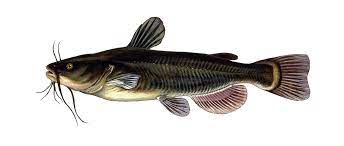
Scientific Name: Ameiurus melas
Description: Body color is grey to black and cream underneath with unforked tail. Black or gray chin barbels. Head and mouth are large, lateral line complete. Up to 5 lb; less than 1 lb typical.
Habitat: Pools, backwaters, slower current or still water. Spawns in shallow weedy areas when water reaches 66-70 degrees. Tolerant of poor quality, muddy water.
Tips: Night fishing near the bottom with minnows, cut bait, stink bait or nightcrawlers. Limb, trot or jug lines are effective.
Range: Tennessee and Coosa River basins.
Bullhead, Brown
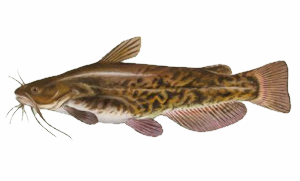
Scientific Name: Ameiurus nebulosus
Description: Color is light brown or yellow with black or gray chin barbels. Pectoral spines deeply serrated, unforked tail. Up to 5 lb; 1 to 2 lb typical.
Habitat: Inhabits still or slowly moving warm waters. Tolerant of poor water quality. Spawns over a sand bottom close to some cover, such as a log or stump, when water reaches 70-75 degrees.
Tips: Chicken livers, worms, doughballs.
Range: Common throughout Georgia.
Current State Record Information
Bullhead, Yellow
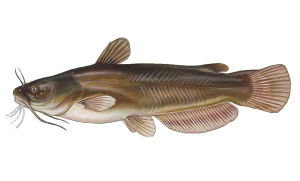
Scientific Name: Ameiurus natalis
Description: Pale yellow body and belly, head and back are solid brown. White chin barbels. Head is large, lateral line complete, unforked tail. Up to 6 lb; 1 to 3 lb typical.
Habitat: Small, shallow lakes, ponds and slow-moving streams with various bottom types from muck to gravel. Spawns in spring when water reaches 60-70 degrees.
Tips: Worms, doughballs, shrimp, liver, cut bait.
Range: Common throughout Georgia.
Current State Record Information
Catfish, Channel
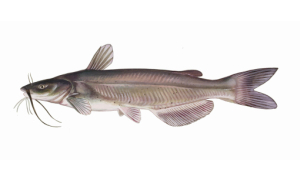
Scientific Name: Ictalurus punctatus
Description: Olive and brown to dark blue body, back not humped, deeply forked tail, anal fin has a curved margin and 24-29 rays. Can exceed 40 lb; 5 to 10 lb typical.
Habitat: Streams, rivers, eddies and shallower water; lakes and ponds. Spawns in cavities in hollow logs, holes in undercut banks and beneath rocks when water reaches 70-75 degrees.
Tips: Most active in the evening or early night. Use worms, cut bait, shrimp, liver, blood and stink baits.
Range: Common throughout Georgia.
Current State Record Information
Catfish, Flathead

Scientific Name: Pylodictis olivaris
Description: Flattened head, yellowish mottled with brown and green; lower jaw extends beyond upper jaw and unforked tail. Very small eyes. Weight can exceed 100 lb; less than 30 lb typical.
Habitat: Deep murky pools with some current; rocky, rubble-bottom areas with holes. Spawning occurs in holes or other sheltered places under rocks and logs when water reaches 70-80 degrees.
Tips: Live bait such as minnows, chubs, crayfish, or sunfish. Use trotlines, setlines or jugs.
Range: Tennessee, Coosa, Chattahoochee, Flint, Ocmulgee, Oconee, Savannah, Altamaha and Satilla River basins.
Current State Record Information
Catfish, Blue
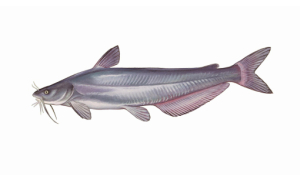
Scientific Name: Ictalurus furcatus
Description: Silvery blue, humped back, eyes small. Anal fin has a straight margin and 30-35 rays. Forked tail. Weights can exceed 100 lb; 1-20 lb typical.
Habitat: Likes flowing water in large rivers, reservoirs and tributaries. Spawns in early summer when water reaches 70-75 degrees, depositing eggs in hollow logs or deeply undercut banks.
Tips: Jug lines and trotlines, fished 4 to 10 feet deep. Live or cut baits, sunfish, gizzard shad, carp, large minnows, skipjack herring and crayfish.
Range: Coosa, Chattahoochee, Flint, Ocmulgee, Oconee, Altamaha, Satilla and Savannah River basins.
Current State Record Information
Catfish, White
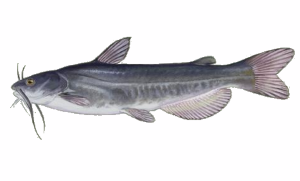
Scientific Name: Ameiurus catus
Description: Upper body is slate gray or steel blue, under belly white, moderately forked tail. Head very wide. Up to 20 lb, most less than 5 lb.
Habitat: Ponds, slow moving streams or slightly brackish water. Migrates short distances to reach suitable spawning areas, spawns under rocks, logs or undercut banks when water reaches 75-80 degrees.
Tips: Live bait, worms, cut bait, shrimp, liver.
Range: Chattahoochee, Flint, Ochlockonee, Ocmulgee, Oconee, Altamaha, Ogeechee, Satilla, St. Marys and Savannah River basins.
Current State Record Information
Common Carp

Scientific Name: Cyprinus carpio
Description: Slate to gold in color with a dark spot at the base of each scale. A single, stiff spine in both the dorsal and anal fins. Sucker-like mouth with a barbell on each corner. Up to 58 lb or more; 5 to 25 lb typical.
Habitat: Found in a wide variety of habitats. Prefers warm, standing or slow-moving water. Spawn in very shallow 59–77-degree water and are often observed splashing about with their backs out of water.
Food Habits: Bottom feeding, worms, small crustaceans and plants.
Tips: Very strong fighter. Doughballs, worms and corn.
Range: Introduced, potentially found statewide.
Current State Record Information
Crappie, Black
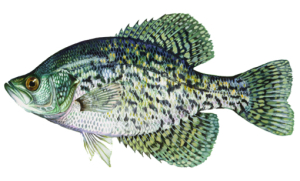
Scientific Name: Pomoxis nigromaculatus
Description: Silvery olive, numerous black spots irregularly spaced over body, 7-8 dorsal spines. Up to 5 lb; usually less than 2 lb.
Habitat: Deeper water with sparse vegetation, still black water lakes and sloughs. Spawns near emergent vegetation close to shore or fine gravel bottom when water temperatures reach 62-65 degrees.
Tips: Live minnows, jigs, worms.
Range: Common throughout Georgia.
Current State Record Information
Crappie, White
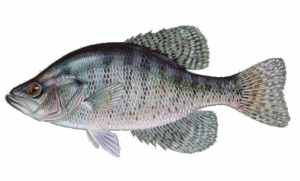
Scientific Name: Pomoxis annularis
Description: Silver olive, 5-6 dorsal spines, vertical dark bars on the sides. Up to 5 lb; less than 2 lb typical.
Habitat: Deep water around drop-offs, stumps, brush or artificial cover. Nests in colonies. Spawns when water reaches 62-65 degrees, then returns to deep water, near drop-offs. More abundant than black crappie in muddy water.
Tips: Fish in brush, logs and weeds. Schooling fish. Use minnows, crickets, worms or jigs.
Range: Tennessee, Coosa, Tallapoosa, Chattahoochee, Flint, Ocmulgee, Oconee and Savannah River basins.
Current State Record Information
Eel, American
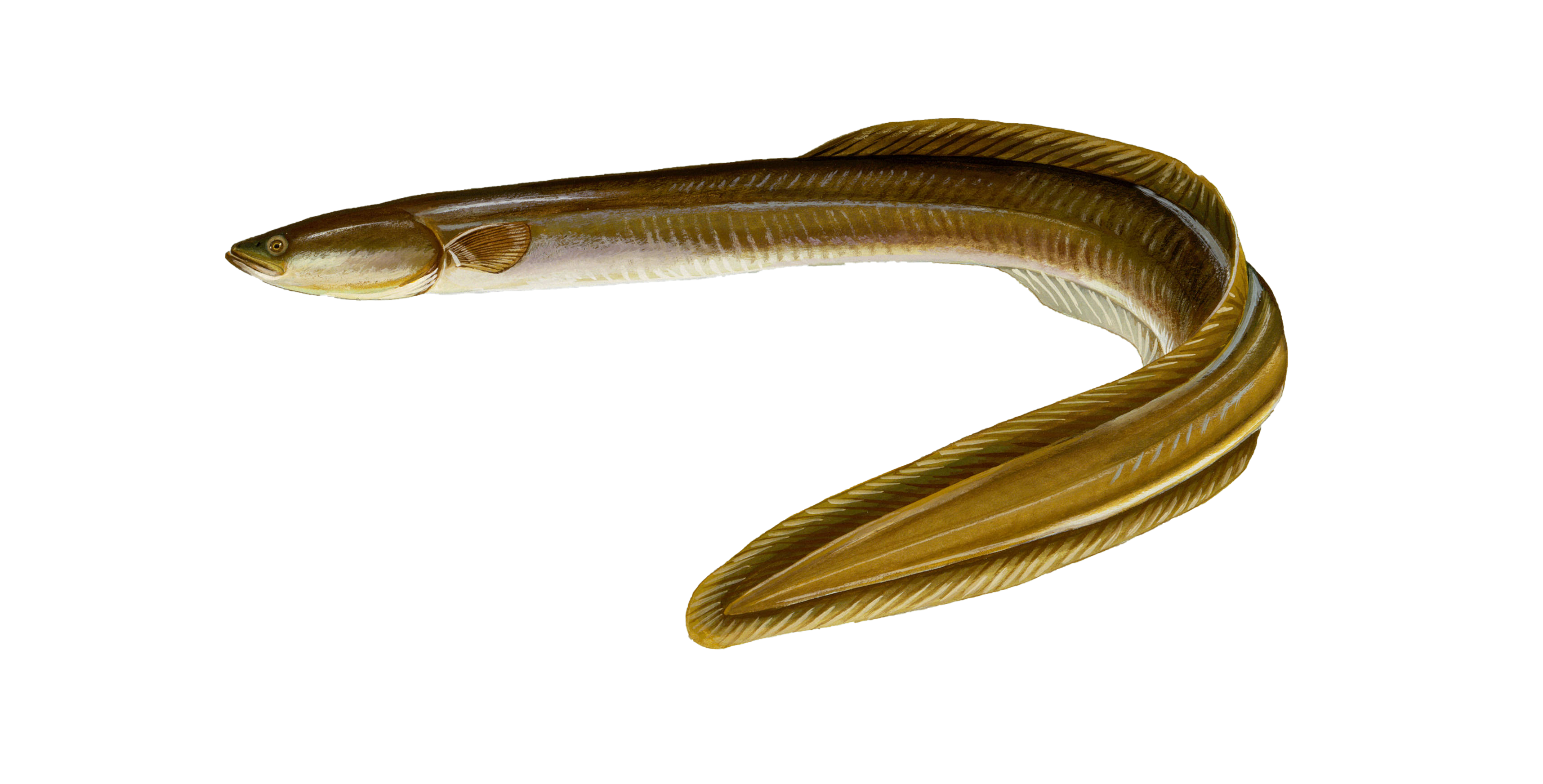
Scientific Name: Anguilla rostrata
Description: Olive green to brown on the back. Head is small, mouth large, numerous small teeth. Body is long, slender, snake-like. Dorsal and anal fins are very long and connect to the tail. Lower jaw projects well beyond upper jaw. Common length is 2 to 3 feet.
Habitat: Rivers, lakes and streams with continuous flow in deep pools, around logs, boulders or other cover. Migrates in fall from fresh to saltwater to spawn.
Food Habits: Crayfish, frogs, fish or insects.
Tips: In freshwater use fish, frogs, and crayfish, and in brackish water dead shrimp may be effective. Mostly caught by accident. Very slimy and hard to hold. Good bait to use for striped bass and several saltwater species.
Range: Middle and Lower Chattahoochee, Lower Flint, Ochlockonee, Suwannee, Satilla, Ocmulgee, Oconee, Altamaha, Ogeechee and Savannah River Basins.
Freshwater Drum
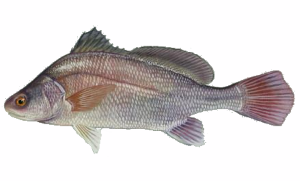
Scientific Name: Aplodinotus grunniens
Description: Silver colored. Humped back with dorsal fin extending almost the entire length of the back. Noticeably rounded caudal fin. Up to 50 lb; 1 to 10 lb typical.
Habitat: Lakes and rivers. Spawning occurs in main channels when water reaches 65-70 degrees. The buoyant eggs are released in open water and dispersed by the current.
Food Habits: Feeds on clams, mussels, snails, crayfish, insects and other fish.
Tips: Plastic or live worms, crayfish, minnows, mussel meat and cut bait. Will strike a small jig worked across the bottom.
Range: Tennessee and Coosa River basins.
Current State Record Information: No current state record
Gar, Longnose

Scientific Name: Lepisosteus osseus
Description: Elongated body, greenish black on top, yellow towards belly. Black spots along the sides and fins. Long, narrow snout with many sharp needle-like teeth. Up to 25 lb.
Habitat: Deep or shallow water of lakes, rivers and streams. Often lurks in weedy areas.
Food Habits: Juveniles and adults are often opportunistic fish eaters but will occasionally eat shrimp, crayfish and insects.
Range: All major river basins in Georgia except the Tallapoosa.
Current State Record Information
Gar, Spotted

Scientific Name: Leipsosteus oculatus
Description: Spots on top of the head, body, and fins. Snout is broader than longnose gar. Up to 20 lb, but most are 1 to 5 lb.
Habitat: Prefer warmer, quiet waters, large reservoirs and rivers.
Food Habits: Juveniles and adults are often opportunistic fish eaters but will occasionally eat shrimp, crayfish and insects.
Range: Tennessee, Coosa, Chattahoochee and Flint River basins.
Pickerel, Chain (Jackfish)

Scientific Name: Esox niger
Description: Olive green on the back, creamy yellow on the belly. Fins clear to amber and without spots. Distinct chain-like or interwoven markings on sides; elongated body shape. Up to 10 lb; 1 to 3 lb most typical.
Habitat: Clear, shallow, heavily vegetated shoal water to the deeper part of lakes. Spawns over submerged vegetation when water reaches 45-50 degrees.
Food Habits: Fish, frogs, insects, crayfish or mice that have fallen in the water.
Tips: Surface lures, spinner baits, spoons or live shiners.
Range: Coosa, Chattahoochee, Flint, Ochlockonee, Suwannee, Satilla, St. Marys, Ocmulgee, Oconee, Altamaha, Ogeechee and Savannah River basins.
Current State Record Information
Pickerel, Redfin
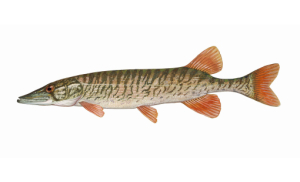
Scientific Name: Esox americanus
Description: Dark brown to black on back. Belly is pale, vertical bars on sides, dorsal fin dark, other fins amber to red. Fins clear, unspotted. Rarely 1 lb.
Habitat: Slow moving rivers and streams. Hides in shallow weed beds or under lily pads. Spawns in early spring when water reaches 40-53 degrees, scattering eggs over dense submerged vegetation.
Food Habits: Fish, frogs, large aquatic insects and tadpoles.
Tips: Surface lures, live shiners, pork rind.
Range: Coosa, Chattahoochee, Flint, Ochlockonee, Suwannee, Satilla, St. Marys, Ocmulgee, Oconee, Altamaha, Ogeechee and Savannah River basins.
Current State Record Information
Shad, American

Scientific Name: Alosa sapidissima
Description: Silvery with single dorsal fin; at least one and up to 5 to 7 dark sports behind the gill plate (operculum). Dorsal fin is short, underside of body is accented with a saw-toothed edge formed of belly scales. No teeth in adults. Up to 12 lb; 2 to 8 lb typical.
Habitat: Spawns in fresh water but spends most of its life at sea. Enters coastal Georgia rivers in winter and early spring (Dec – May). Most spawning occurs when water reaches 53-70 degrees and dependent on water clarity, with late afternoon spawning in clear water and all day in turbid waters.
Food Habits: At sea, they consume other fish or small crustaceans (copepods, mysid shrimp). Juveniles in freshwater or at sea feed almost exclusively on small crustaceans. Spawning run adults typically feed only on wood and green plant debris, though fish may occasionally strike lures.
Tips: Upstream migrating fish exhibit reduced feeding, but may strike at flies or any small, flashy lure or small fish.
Range: St. Marys, Satilla, Ocmulgee, Oconee, Altamaha, Ogeechee and Savannah River basins.
Current State Record Information
Shad, Hickory
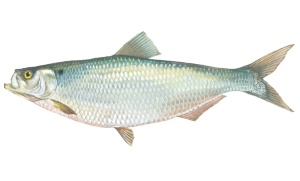
Scientific Name: Alosa mediocris
Description: Silvery with single dorsal fin; strongly oblique mouth; blue-black spot near upper edge of gill cover followed by row of poorly defined dusky spots reaching to below dorsal fin; lower jaw projects well beyond upper jaw; teeth on lower jaw.
Habitat: Spawns in fresh water when water temperatures between 58-62 degrees but spends most of its life at sea. Enters coastal Georgia rivers in winter and early spring (Dec – Apr).
Food Habits: At sea and in coastal waters feeds on small fish, squid, fish eggs, small crabs and crustaceans. Like American shad it is believed they do not feed much during the spawning run but may occasionally strike minnows or artificial lures.
Tips: Upstream migrating fish exhibit reduced feeding, but may strike at flies, artificial lures like flashy spoons and small fish/minnows.
Range: Ocmulgee, Altamaha, Ogeechee and Savannah River basins.
Current State Record Information
Smallmouth Buffalo

Scientific Name: Ictiobus bubalus
Description: Light gray to dark gray, black; large head. Body is compressed with a higher arch in the back, small mouth slants downward. Up to 20 lb; 6 to 8 lb typical.
Habitat: Common in large rivers and streams. Occur in fairly deep, swift runs of large rivers.
Food Habits: Crustaceans, mollusks, insect larvae and plants.
Tips: Doughballs and worms.
Range: Coosa River basin.
Current State Record Information: No current state record
Sunfish, Bluegill
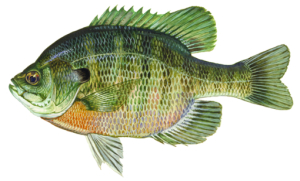
Scientific Name: Lepomis macrochirus
Description: Deep bodied, slab-sided fish with a small mouth. Black spot on soft dorsal fin, flexible black ear flap. Up to 4 lb; 1 lb and less typical.
Habitat: Congregates around vegetation and sunken trees of shallow backwater bays, lakes and ponds. Spawning occurs when water reaches 67-70 degrees in shallow areas over sand and gravel. Nests in colonies and can spawn monthly during spring/summer.
Tips: Worms, crickets, meal worms, small jigs, spinners to poppers.
Range: Common throughout Georgia.
Current State Record Information
Sunfish, Flier
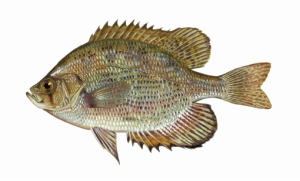
Scientific Name: Centrarchus macropterus
Description: Dark green, olive. Scales are marked with a brown spot forming a series of horizontal lines; long anal fin, 7-8 anal spines. Most less than ½ lb.
Habitat: Sluggish lowland habitats such as swamps, bayous and other weedy water. Often one of the most common recreational fish in very acidic waterbodies, such as the Okefenokee Swamp. Rarely found in flowing waters. Spawns in spring when water reaches 68-73 degrees. Male digs nests in shallow water near the shore. Nests in colonies.
Tips: Worms, crickets, small jigs, spinners to poppers. Because of the flier’s tendency to rise to the surface, fly fishing is effective.
Range: Chattahoochee, Flint, Ocmulgee, Oconee, Ochlockonee, Suwannee, St. Marys, Satilla, Altamaha, Ogeechee and Lower Savannah River basins.
Current State Record Information
Sunfish, Green
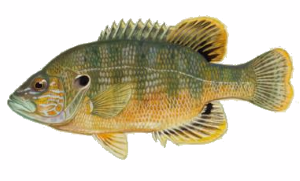
Scientific Name: Lepomis cyanellus
Description: Green sunfish share the black spot in the soft dorsal fin like Bluegill but have a larger mouth and yellow to orange color in margins of caudal and anal fins. Introduced to much of Georgia. Can hybridize with other Lepomis species.
Habitat: Submerged cover and undercut banks
Tips: Use worms, crickets, grubs, insect larvae or small jigs.
Range: Native to northwest Georgia but commonly found in the piedmont and southeastern plains. Tennessee, Coosa, Tallapoosa, Chattahoochee, Flint, Ocmulgee, Oconee, Ogeechee, Altamaha, Ochlockonee, Suwannee and Savannah River basins.
Current State Record Information
Sunfish, Longear
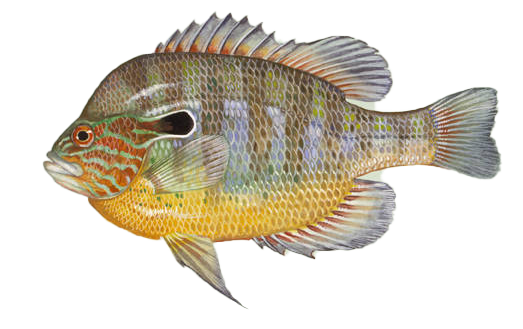
Scientific Name: Lepomis megalotis
Description: Colorful. Head has blue stripes, and breast and belly are red or orange. Black gill flap is long and flexible, with a white edge completely around. Short, rounded pectoral fins. Rarely reaches 1 lb.
Habitat: Unpolluted shallow waters of lakes or streams. Spawns in deeper water when temperature reaches 70-80 degrees.
Tips: Worms, crickets or small artificial baits.
Range: Tennessee, Coosa, Tallapoosa, Chattahoochee and Oconee River basins.
Sunfish, Redear (Shellcracker)
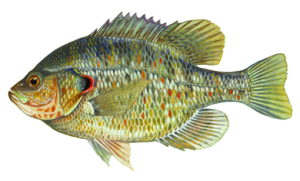
Scientific Name: Lepomis microlophus
Description: Dark olive above, yellow to green on the sides, white on belly. Red edge on the gill cover on the male and orange on the female. Up to 4 lb; rarely over 1 lb.
Habitat: Bottom of clear, quiet waters with moderate vegetation. Spawns when water reaches 60-70 degrees, in deeper water; nests in colonies.
Tips: Use worms, crickets, grubs, insect larvae or small jigs.
Range: Common throughout Georgia.
Current State Record Information
Sunfish, Redbreast
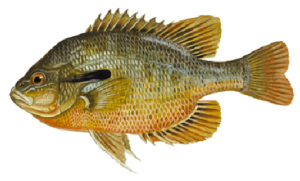
Scientific Name: Lepomis auritus
Description: Belly is yellow to orange-red or crimson red, gill flap is long and narrow. Head has blue or blue-green stripes. Most less than 1 lb.
Habitat: Prefers streams and rivers, but also found in some lakes. Likes gravel or rocky bottoms, concentrates around boulders, limestone outcroppings and aquatic vegetation. Spawns when water reaches 65-75 degrees, later than most sunfish. Might use abandoned nests of other sunfish.
Tips: Unlike other sunfish, redbreast can be caught at night using a wide variety of lures and baits. Beetle spins and small spinners.
Range: Common throughout Georgia.
Current State Record Information
Sunfish, Rock Bass

Scientific Name: Ambloplites rupestris
Description: Dark olive in color, scales have a dark spot. The mouth is large and the eye rimmed with red. Five or six spines in the anal fin. Most less than 1 lb.
Habitat: Deep pool in clear, rocky, or sandy streams. Spawning activity occurs in water 60-70 degrees.
Tips: Use crayfish, minnows or artificial lures including jigs and crankbaits.
Range: Tennessee, Upper Chattahoochee and Upper Savannah River basins.
Current State Record Information
Sunfish, Shadow Bass
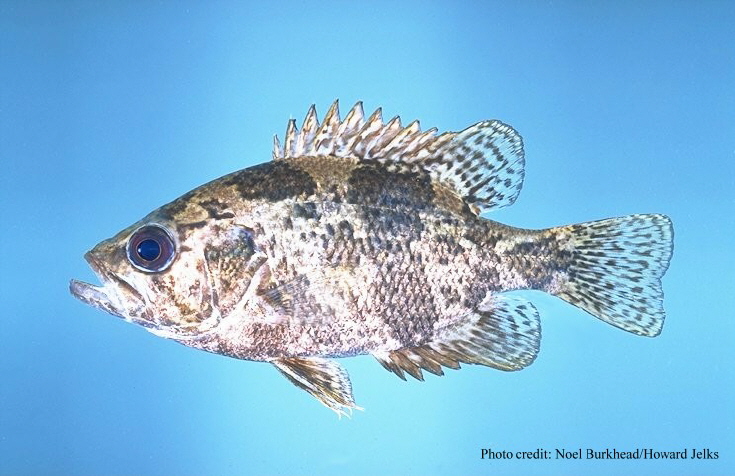
Scientific Name: Ambloplites ariommus
Description: Dark olive in color with irregular marbling. Mouth is large and the eye rimmed with red. Five or six spines in the anal fin. Most less than 1 lb.
Habitat: Deep pools in clear rocky streams. Spawning activity occurs in water 60-70 degrees.
Tips: Not common but will strike almost any bait small enough.
Range: Coosa, Tallapoosa, Chattahoochee and Flint River basins.
Current State Record Information
Sunfish, Spotted
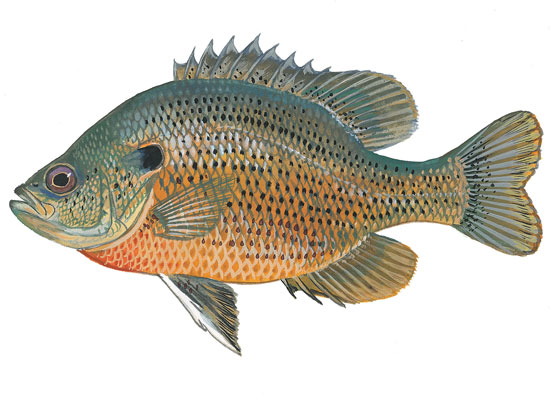
Scientific Name: Lepomis punctatus
Description: Dark olive or brown above, sides are light green or olive and covered with small black spots. Fins are dusky orange. Body is very deep. Rarely reaches ½ lb.
Habitat: Usually found in heavily vegetated, slow-moving lowland streams and warm shallow ponds. Small or large creeks and large rivers extending into brackish tidal regions. Spawns in spring in shallow 68–73-degree water near shore.
Tips: Nicknamed “stumpknocker” because it orients strongly to stumps where it finds food. Worms, crickets, small spinners, flies and popping bugs.
Range: Ocmulgee, Oconee, Altamaha, Ogeechee, Ochlockonee, Suwannee, St. Mary’s, Satilla and Savannah River basins.
Current State Record Information
Sunfish, Warmouth
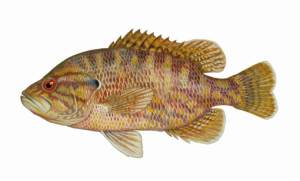
Scientific Name: Lepomis gulosus
Description: Dark olive to gray with brownish sides and yellow markings. Each side of the head has five dark lines radiating from snout and eye. Anal fin has three spines. Large mouth. Red mark on gill flap. Up to 1 lb.
Habitat: Shallow, slow floating mud-bottom creeks, ponds, lakes and swamps. Spawns in shallow 65–70 degree water, nest builder.
Tips: Small minnows, live crayfish and worms.
Range: Common throughout Georgia.
Current State Record Information
Trout, Brook
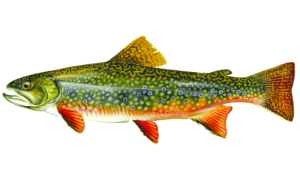
Scientific Name: Salvelinus fontinalis
Description: Backs and sides are dark olive or gray colored, and its belly is white. Black worm-like markings are present on its back. Pale spots on the sides with a few red spots with blue halos. White stripes border on all fins except dorsal. Caudal fin is lightly forked. Up to 15 lb; rarely over 2 lb.
Habitat: They are found in high elevation, small, clear, cold-water mountain streams. Spawning occurs in fall in shallow running 44–55 degree water on gravel beds.
Food Habits: Primarily insects, snails, salamanders and small fish.
Range: Tennessee, Coosa, Chattahoochee and Savannah River basins. Georgia is the southern-most extent of the natural range of brook trout in the eastern United States.
Current State Record Information
Trout, Brown
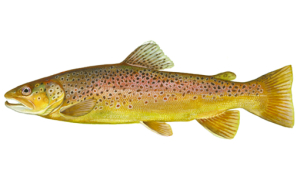
Scientific Name: Salmo trutta
Description: The back and sides are golden to olive brown with yellow bellies. Large, irregular, dark brown spots occur on the sides. Red spots surrounded by blue halos are present from head to tail and are especially vibrant during spawning season. Tail fin almost square and not spotted. Up to 40 lb; rarely over 5 lb.
Habitat: Clear, cold-water streams with woody debris. Spawning occurs in fall, selecting a gravel spot in shallow running 44–48-degree water.
Food Habits: Primarily insects, crustaceans and and fish.
Range: Tennessee, Coosa, Chattahoochee and Savannah River basins.
Current State Record Information
Trout, Rainbow
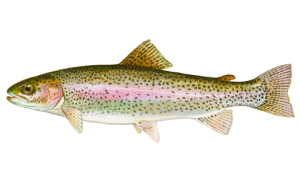
Scientific Name: Oncorhyncus mykiss
Description: Vibrant pink or red stripe extends down its sides. White to silvery belly. Numerous black spots are present on the back, dorsal and tail fins. Tail is slightly forked. Up to 32 lb; rarely over 5 lb.
Habitat: Cold-water streams. Spawning occurs in spring or fall over a gravel bed in shallow running 50–60-degree water.
Food Habits: Insects, crustaceans and fish.
Range: Tennessee, Coosa, Tallapoosa, Chattahoochee and Savannah River basins.
Current State Record Information
Walleye

Scientific Name: Sander vitreus
Description: Golden brown colored body with a white belly. Large, glassy marble-like eyes and long, sharp teeth. Two dorsal fins. Whitish area on lower lobe of caudal fin. Up to 15 lb; 1 to 2 lb typical.
Habitat: Large, cool water rivers and lakes. Frequently found near boulders, points and humps. Spawns in spring when water reaches 45-50 degrees over rocky bottoms in rivers.
Food Habits: Other fish, leeches, crayfish and insects.
Tips: Minnows, nightcrawlers, jigs, plugs and spinner combos.
Range: Tennessee, Coosa, Chattahoochee and Savannah River basins.
Current State Record Information
Yellow Perch
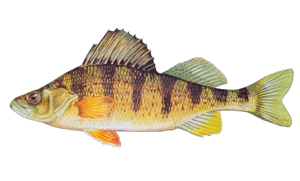
Scientific Name: Perca flavescens
Description: Golden yellow body, with 6-8 dark vertical bands from back to belly. Two dorsal fins. Bright orange fins. Up to 5 lb; less than 1 lb typical.
Habitat: Prefers cool water lake environments, but also found in large rivers, tailwaters and ponds. Moves in schools and spawns in the backwaters near vegetation in the spring when water reaches 44-54 degrees.
Food Habits: Small fish, aquatic insects, crayfish and snails.
Tips: Minnows, small jigs, grubs and worms fished near the bottom. Use light tackle.
Range: Tennessee, Coosa, Tallapoosa, Chattahoochee, Flint, Ocmulgee, Oconee, Altamaha and Savannah River basins.
Current State Record Information
ARTWORK CREDITS:
For all 10 of the black bass species (Largemouth, Smallmouth, Shoal, Suwannee, Spotted, Redeye, Chattahoochee, Tallapoosa, Altamaha, Bartrams) the artist is Joseph Tomelleri.
For the shadow bass photo, credit is given to Noel Burkhead/Howard Jelks of USGS.
All other illustrated images are credited to Duane Raver/USFWS.

















